March 13th, 2014 — 6:37pm
***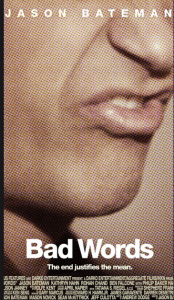
Bad Words-sp This is Jason Bateman’s directorial debut starring Jason Bateman. It can be described as a mean or subversive comedy. The main character says and does cruel things to other people including a bunch of preteen kids which although they are “funny†they are not very nice.We meet Guy Trilby (Bateman) as a 40 year old guy who is entering the national spelling bee contest which he is determined to win and claims the right to be in it since he meets the criteria of never completing the 8th grade.He is accompanied by a reporter (Kathryn Hahn) doing a story about his endeavor for a web site. He overcomes the objections of Dr. Bernice Deagan (Allison Janney), one of the administrators, and confronts the founder of the contest, Dr. Bowman(Phillip Baker Hall), who are both furious at him, as are all the parents of the young other contestants. Trilby plays distracting mean tricks on some of the kids to get them eliminated from the competition. He does befriend one of the kids, 10 year old Indian boy Chaitanya Chopra with whom there is a hint that he identifies with him. We see terrific chemistry between the two and a great acting job by a young boy by the name of Rohan Chand. And now for an announcement SPOILER ALERT which is necessary although we probably knew the secret for 1/5 of the film and still enjoyed it. The question, of course, is why would a 40 year old man undertake this mission? The answer has something to do with the fact that we learn that the founder of the contest, Dr. Bowman, actually once as a traveling salesman met Philby’s  mother and became his biological father but never stayed around and of course does not know this fact. Philby had found this out recently just before his mother died and now is on the mission to screw up the good doctor’s prestigious spelling contest. In the end this makes for an interesting, funny and ultimately a feel good movie that many people will enjoy seeing.  But his film fascinated once of us (MB) because we have observed some variation of this theme is numerous movies played out in different ways, as well as having seen it in several real life situations. But in each case the motivation and the actions of the person searching for his or her biological parent or child is different. It certainly is not always vindictive as in this story and sometimes it is to establish a meaningful connection. Here are some films and our reviews where this was the main theme:
Philomena -Elderly British woman who had child out of wedlock in convent goes to US to find out what happened to him. Stars Oscar nominated Judy Dench
The Kids Are All Right– Two lesbian parents are raising two teenage kids who decide to search out their sperm donor biological dad. Annette Bening, Julianne Moore and Mark Ruffalo
People Like Us – A man and woman never realized they were from the same parent Elizabeth Banks , Chris Pine and Michelle Pfeiffer
Stories We Tell – Documentary by a woman who uncovers secrets of her family and that she was not her father’s child. Sarah Polley
Admission– Assistant Dean of Admissions realizes an applicant is her child given up at birth- Tina Fey, Lily Tomlin and Pail Rudd
Mother and Child   Mother child relationships . Children given up for adoption and fantasies of children who want to reunite with their mother. Annette Bening and Noemi Watts
I have also written about three cases from real life in my PsychiatryTalk.com blog (http://www.psychiatrytalk.com/2012/07/discussion-of-the-phenomena-of-unknown-family-members/)      (2014)
Â
Comment » | 3 Stars, Comedy
March 11th, 2014 — 7:12am
*****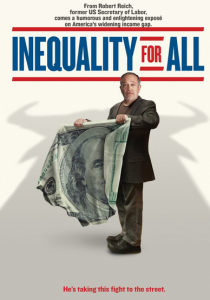
Inequality For All- nf This is an amazing documentary that is all about Robert Reich who presents as clear an explanation of the economy- where it has been and where it is going, as we have ever seen. He makes it clear why there is big disparity between the 1% and the 99% in the U.S. and what that should really mean to all of us. Reich was Secretary of Labor and a key advisor to Bill Clinton. He started in polities in the Carter administration and more recently teaches at University of California at Berkley. In fact, a good part of this film is directly from his class lecture at that school. His discussion, his graphs, his examples and his logic come across crystal clear, as does his sincerity. He makes the point, with very easy to understand facts and figures, that this country has thrived when there was less disparity between the wealthy and the middle class and how when the middle class earnings flattened out and the very wealthy began to make more money than ever, the economy of the US took a nose dive (i.e. in 1929 and 2008). Reich not only spoke with articulate people in the middle class who have seen their savings erode but he also spoke with a multimillionaire who acknowledges that he and others like him invest most of their money abroad in hedge funds (not in creating new jobs in this country). We also get the views of Warren Buffet who ridicules the tax structure in this country where he pays less percentage of his income on taxes than does his secretary(13% vs 36%). Mitt Romney paid 11%.  We see how in the 1980s, women entering the job market saved the middle class by providing a second  income for middle class families, but now as globalization takes the jobs out of the US and automation limits employment, that won’t save the economy anymore. The middle class has to have disposable income to buy products in order for our economy to thrive. The rich people can only buy so many cars, pillowcases or other products. The shrinking middle class income is putting the economy of this country into deep trouble. Trickle down economics clearly doesn’t work. On top of all this the recent Supreme Court “ Citizens United “ case now supports the wealthy to basically put unlimited funds into political campaigns which makes it even more difficult to make any change. Obviously this is heavy stuff. Perhaps the most uplifting part about this depressing picture is the commitment of Reich to tell the story and his optimism that the next generation will make the changes that are necessary. No matter what part of the political spectrum you come from you should see this film. Whether you think you agree or disagree with this guy, you will be enriched by the insight into these complicated economic issues. The movie, directed by Jacob Kornbluth is well done, with illustrative archival clips, good close-up views into the character of many of the people who appear in the film and appropriate music that moves this film along. As all good documentaries should do, it also leaves you with a good website,  Inequalityforall.com which shows you how you can get involved. (2013)
Comment » | 5 Stars, Documentary
March 6th, 2014 — 8:06pm
****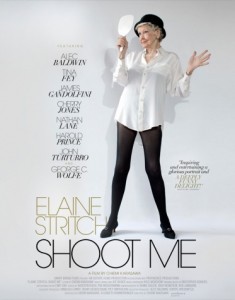
Elaine Stritch: Shoot Me– If you love Elaine Stritch, dramatic actress, singer, musical comedy star and Broadway legend you will want to see this documentary. If you want to meet a remarkable 87 year old star who speaks her mind and is not afraid to tell you she that still needs the love of her audiences, you will want to see this documentary. While one might think that the filmmaker Chiemi Karasawa had always been an avid fan of the subject of this film, you will be surprised to learn that this was not the case. In fact, her interest was stimulated by their mutual hairdresser, who suggested that Stritch would be the ideal subject for a documentary. Karasawa then unearthed everything she could about this woman and ultimately convinced Ms. Stritch to let her do the film. Stritch, who never does anything half way granted the filmmaker full access to her life and embraced the project with the intensity and humor, which is so much a part of her character. The film is not a retrospective review of this amazing person, although it certainly gives you ample glimpses of her star-studded career. But rather it is the story of an elderly woman facing the challenges of life with concerns about her health and memory who nevertheless is still up for another show, another concert, another rehearsal, another review, all with energy and, yes, with great vitality. And this woman can still sing! It is exciting to see her rehearse with her music director as she prepares for her latest cabaret performance at the famed Café Carlyle as she lives in her suite at that same hotel. You can almost hear Frank Sinatra singing New York New York as she hustles down a Manhattan street. All of this is quite real as is her hospitalization at Mount Sinai Hospital for hypoglycemia related to her diabetes. The camera doesn’t miss a beat nor does Ms. Stritch. Two unforgettable moments are the look on a young Stephen Sondheim’s face as a young Elaine Stritch nails one of his songs and another moment when an older Stritch marvels how Sondheim’s words so often captured her own feelings. We come away from this film with a picture of the legend, who once turned down JFK’ s offer to join her at her apartment one evening. A woman who could never find a love to replace her 10 year marriage to John Bay actor and playwright who died in 1982 of a brain tumor and every year still send English Muffins from her husband’s family muffin business to hundreds of her friends. A woman who has been nominated for multiple Tony’s, Emmys and what have you and a woman who is now sure to be unforgettable to new and old fans thanks to this film.  (2014)
Comment » | 4 Stars, Documentary
February 20th, 2014 — 9:02pm
****
In Secret-sp Emile Zola is a great French writer known for the Naturalism Literary School which depicts realism, human experience and morality or the lack of it. This film is closely based on one of his classic  novels of this genre Therese Raquin.  Charlie Stratton as Executive Producer, screen writer and director certainly achieved a realistic 19th century Paris setting (although filmed in Budapest) as well as a dramatic film noir atmosphere. But it was the character portrayals, which riveted the audience and allows Zola’s captivating storyline to hold them spellbound. Therese (Elizabeth Olsen) is a beautiful sex starved and obsessed young woman who is forced into a loveless marriage with her nerdy cousin Camille (Tom Felton) after her mother dies and left her in the care of her aunt, magnificently played by Jessica Lange. Laurent LeClaire (Oscar Isaac) an old artist friend of Camille appears on the scene and there is immediately intense chemistry between him and Therese, which is secretly acted out. It would not be a Zola story if jealousy and passion does not lead to murder! Things cannot be expected to be simple even at this point as there is intense grief, all kinds of strong emotional feelings, delayed gratification and tremendous guilt which seems to be on verge of destroying of what was an intense all-encompassing relationship. The movie will grip you and hold your attention as well as any great TV show but the subtle, complexities and all the dark shadows as well as the absolutely great acting and directing remind you that you have seen a first rate movie. (2014)
Â
Comment » | 4 Stars, Drama, Mystery
February 17th, 2014 — 3:40am
***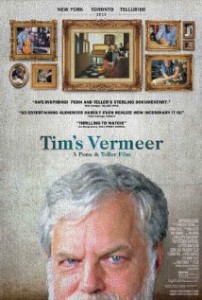
Tim’s Vermeer– rm– Johannes Vermeer is a Dutch painter who lived 350 years ago. He is known for his magnificent paintings of mostly indoor scenes with exquisite photo like detail capturing shadows and variations in light as good if not better than any of the master painters of that time. Tim Jenison is a successful businessman and inventor who develops the idea that Vermeer may have been using a little â€magic†in creating his paintings. He did this by using some tricky optics with a mirror and a variation of camera obscura. Jenison postulated that Vermeer was reflecting the light from the subject through a small hole on to a mirror and then to the canvas where he could perfectly match the color paint over the reflection, which resulted in the unusual realism which the painter achieved. Jenison’s best friend is Penn Jilette the well know magician showman who collaborates with Jenison along with Penn’s performing partner Teller who directs the film as they team up to make this documentary. Jension, only using the technology of the painter’s time period, not only constructs the optic device that he believes Vermeer must have used but he recreates the studio where he painted in the exact dimensions as possible. He then builds a setup to copy and reconstruct the detailed background including the costumes of the subjects in Vermeer’s classic painting The Music Lesson using models to pose as they were in the painting. Now here is the amazing part, Mr. Jenison, who notes that he is not an artist, but using brushes and paints that were around 350 years ago meticulously matches the exact colors and paints them on the images being reflected on his canvas. It takes him over 4 months of almost continuous painstaking work but this non artist creates a painting which seems to very closely resemble Vermeer’s masterpiece and his unusual realistic style. The entire procedure was documented by a film crew, with Penn narrating and Teller directing the movie. They also bring in the well known British painter David Hockney who acknowledges that on the basis of the picture which Tim Jenison has created, he has made the case that he has discovered the secret to Vermeer’s success. This in one sense would seem to discredit this master although he should be credited at least for his composition. There is no known record of the artist being familiar or experimenting with optical devices that were available at the time. Apparently there are also no known writings about any other artist at that time or subsequently who use this technique, which makes this all more remarkable. To further support this theory, Jenison discovered a very faint blue outline on some object in the Vermeer painting which would have no reason to be there but could have been created by a chromatic abnormality of the mirror. We would imagine that if the nobles of the time had discovered that an artist could paint such realistic perfect reproductions, they might be in quite demand (although maybe an artist who produces more creatively flattering portraits would be chosen). We know that some artists today will paint over photographs but we believe that x-ray techniques would uncover the underlying picture if they claimed them to be original paintings. We wonder if a devious contemporary would-be artist might be able promote himself as a master when he was only secretly using this technique? In conclusion, perhaps it is fitting and perhaps ironic that the magician showmen Penn and Teller have produced a documentary film, which may have discovered an important magic trick that has gone undiscovered for more than 3 centuries! It took them 80 minutes to demonstrate how they believe Vermeer pulled it off.  Perhaps they could have done it with a short twenty-minute documentary but nevertheless it is sure to make big ripples in the art world. (2014)
Comment » | 3 Stars, Documentary
February 15th, 2014 — 10:05pm
****
The Monuments Men -Guest Review
This is a guest review by Ron Turco, M.D. Dr. Turco is a psychiatrist and psychoanalyst from Portalnd, Oregon. He is Chair of the Committee on Art, Culture and Creativity of the American Academy of Psychoanalysis and Dynamic Psychiatry
I read with substantial disappointment David Denby’s shallow and un-insightful review of George Clooney’s new film “The Monuments Men.†(New Yorker – Feb. 17-24, 2014).He compares this film to the old Frankenheimer movie “The Train.â€Â There is no comparison, as the train was not historically accurate and barely mentioned in passing Rose Valland, Temporary Custodian at the Jeu de Paume whose influence was so important in the discovery of looted works in France, at the risk of her own life, that she received the French Legion of Honor and the Medal of Resistance becoming a Commander of the Order of Arts and Letters, making her one of the most decorated women in France. She also received a Medal of Freedom from the United States in 1948 and an Officer’s Cross of the Order of Merit from the Federal Republic of Germany. It was her book “Le Front deL’Art†that was the basis of the 1965 movie “The Trainâ€, a movie in which she was only briefly mentioned, although she had also received a commission in the French First Army.
 The Monuments Men were a group of men and women from thirteen nations, most of whom volunteered for service in the newly created Monuments, Fine Arts and and Archives section (MFAA) of the military, attempting to save as much of the culture of Europe and Western Civilization as possible and were willing to fight and die for something greater than themselves. Some were killed in combat.
George Clooney has done an outstanding job with his film “The Monuments Men†and in reminding us that the story of The Holocaust must be told over and over again in different ways and at different times. He masterfully and in sometimes direct or subtle ways brings out the Nazi horror and disregard for human life. Mr Denby has missed the point entirely in his understanding of these heroes and heroines and mentions that most of the works were returned to private collectors. That is not completely true. The works were returned to the countries of origin or to the Jews from whom they were stolen. In the film George Clooney also does an excellent job in presenting the value and importance of the sacrifices of the MFAA people, a job that was endorsed by Franklin D. Roosevelt and strongly supported by Dwight D. Eisenhower. Many of these people went on, after the war, to make substantial contributions to art and culture. Private First Class Lincoln Kirstein founded the legendary New York City Ballet as one of the most important cultural figures of his generation. Second Lieutenant James J. Rorimer, who worked closely with Rose Valland, was instrumental in founding the Met’s medieval collections branch, the Cloisters. “The Monuments Men†film is very close to the facts (a few minor changes, as with all films, including “Lincoln†and “The Navajo Code Talkersâ€). The acting is superb and I highly recommend this film, especially to young people who may not have an understanding of the broad ramifications of The Holocaust or the history of these brave people. John Edsel’s scholarly book “The Monuments Men†should be required reading in high schools throughout our country. (2014)
Comment » | 4 Stars, Drama, History, War
February 14th, 2014 — 11:48pm
*****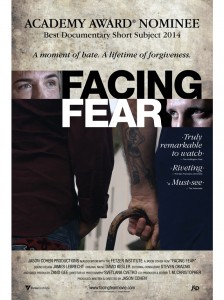
Facing Fear-sp We doubt very much that most of the readers of this blog will see this short documentary film (20 minutes) that has been nominated for an Academy Award. However, when it turns up on TV you should take the time to see it and if you are involved with educating people about bullying, overcoming prejudice and similar issues, you will want a copy of this DVD when it comes out.
As a 13 year-old, Mathew Boger was literally thrown out of his house when he told his mother that he was gay. He ended up spending most of the next few years living in the street of Los Angeles. Tim Zale grew up part of neo-Nazi Skinhead gang with a large tomahawk hair cut on his mostly shaven head. He and his buddies would cruise the streets of Los Angeles getting into fights and bullying some of the homeless people they encountered. This was to be the case late one night in front of a well- known LA hamburger place where Zale and his pals encountered Boger alone in the street. They beat him up and while he was on the ground Zale delivered kicks to head and face with a boot that had a razor in the toe. They left him believing he was dead.
Boger survived, but the hate and persistent anger at his attackers was part of his fantasy life for many years. Both young men moved on with their lives. Zale went to school, ultimately received a Masters Degree and had a family. His thinking began to change when he saw some of his hate and prejudice towards various groups being verbalized by his own son. Boger established a long-term relationship and eventually got a job as an administrator in charge of tours at the Museum of Tolerance in Los Angeles. By coincidence, Zale began to volunteer to give tours and lectures to the public at this iconic museum, which is best known for graphic depiction and personal stories of the horrors caused by Nazis during the Holocaust. During his time there Zale would share how his thinking had evolved over the years. One day they both were lecturing a group together and by the details Zale was describing of his youth, Boger realized that Zale was part of the group that almost killed him. They began to have private discussions and both immediately knew that it was Zale who delivered the nearly fatal blow to his new colleague at the museum and left him for dead twenty-five years before.
Director and Producer Jason Cohen very skillfully weaved the narrative told by both men with very effective images of the streets of Los Angeles. There were some photographs of Zale and his buddies in their earlier days as skin-heads but there were no photos available of Bogart as the homeless street kid. Miraculously, Bogart’s sister had some old films of him as an infant and a small child with his very attractive mother. Credit should also be give to Director of Photography Svetlana Cvetko, who won an Academy Award for Inside Job and veteran Editor and Co-Producer Tom Christopher who has worked in the past with George Lucas and others.   Â
The tremendous value of this film is to watch up close the ruminations of Bogart and Zale as they examine their feelings about each other and what happened in the past. Bogart’s incredible journey to forgive not only Zale but also his mother is quite remarkable. Zale’s task to face Boger and ask for forgiveness and then also to forgive himself is also quite dramatic as well.
We cannot think of a better teaching tool to show to students as well as victims and perpetrators of prejudice. It can only be a wonderful instrument to stimulate discussion, self-reflection and insight. The filmmakers, having received this unexpected recognition of an Academy Award nomination, plan to have their work available to those who want to see it and use it for these purposes. For more information about the film you can go to their website:Â http://www.facingfearmovie.com/Â Â (2014)
Â
Comment » | 5 Stars, Documentary
January 30th, 2014 — 8:35am
****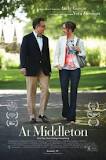
At Middleton – sp-   A middle-aged husband and wife (not married to each other) bring their own teenage child to a beautiful college for the perennial campus tour. He (Andy Garcia) in suit jacket and bow tie, a little awkward, is a cardiac surgeon, She (Vera Farmiga) attractive, good sense of humor, sells high-end children’s furniture. They begin to casually interact and become separated from the tour and take their own tour of the campus. Hence the premise of the film which is stated somewhere in the dialogue is revealed. What if you get your kid ready to go to college and you realize that you are not happy with the life you now have with your spouse? You come to this realization in the midst of a totally enjoyable interaction with this complete stranger with whom you are now spending a few delightful hours. The screenplay by Glenn German and Adam Rodgers (who also directed it) was co-produced by Garcia who discussed the movie in a post screening meeting. The script he said required hardly any additions or changes by the actors during the 21 days shooting. In fact, there literally were no rehearsals as most of the time they went  straight to the camera with cinematography by the esteemed Emmanuel Kadosh. The music was by the famed Cuban musician Arturo Sandoval who was actually played by Andy Garcia in a 2000 HBO biographical drama. It captured the moods of the film quite well, which ranged from the pulsating excitement of new adventure to the sentimentality and sorrow of what could have been. The story was unpredictable and quite creative as it used the beautiful setting of this idyllic campus with magnificent overlook which rapidly changed to an amazing scene of the unlikely couple taking part in a college acting class where their inner most feelings were revealed. This low budget (2 ½ million dollars) independent film is worth seeing and we believe it will hold up well as new films of 2014 are released. (2014)
Comment » | 4 Stars, Drama, Romance
January 24th, 2014 — 6:03am
***
Like Father, Like Son- sp  This Japanese film with subtitles was an extremely successful in Japan earning so far more than 30 million dollars and is about to be released in the United States. It won a major award at the Cannes Film Festival where Steven Spielberg was the Chair of the committee that gave the award. Spielberg then optioned the rights to it and plans to make an English version. What is it about this movie that seems so captivating? In Japan it helps that the male lead is played by one of most popular singers and actors currently in Japan and that is Fukuyama Masahuro. Just as important is the screenplay written by the director Kore-Eda Hirokazu which presents a fascinating human dilemma which rarely happens in modern times but one to which just about everyone can relate. Early in the film, a young married couple with a six year old son, who is a bright, very delightful boy, learn that their son was switched at birth with another child born in the same hospital on the same day. They meet the other family and the differences between them, especially the fathers become very apparent. They must decide what will they do (in addition to suing the hospital). Will they switch children and how will they come to this decision? As we try to relate to the dilemma and see how the parents and children react to this situation, we get the impression that some of the responses seem to be culture bound. Of particular note was the depiction of the passivity of the women and the obedience of the 6 year-olds. In a post film discussion, we learned that in the 1970s when hospital practices in Japan in labeling newborn children were not as exacting as they are today, there were incidences such as the one depicted in the movie. Interestingly, we were told that 100% of the children were returned to the biological parent even in cases of 6 year olds! Director Hirokazu did a sensitive job of showing us the evolution in the thinking of one of the fathers as he leads us to the ultimate outcome of this dilemma. He also brought to the screen two delightful children who played the kids who were switched at birth.
The theme of this movie is a variation of the successful 2013 film Philomena, as well as other movies which we have reviewed and discussed this interesting psychological variable . These include The Kids Are All Right, People Like Us, Stories We Tell, , Admissions, and Mother and Child. One of us (MB)has also discussed this elsewhere with real life case examples (Psychiatrytalk.com). Each of these movie reviews and the psychiatry blog can be reached directly by clicking the words in this paragraph. (2013)
Â
Comment » | 3 Stars, Drama, Foreign
January 20th, 2014 — 12:02am
***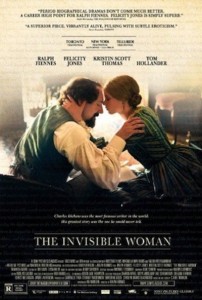 The Invisible Woman- rm. The poster for this movie tries to summarize the story as follows: Charles Dickens was the most famous writer in the world. His greatest story was the one he could never tell. This is a story of Nelly, an 18 year old actress (Felicity Jones) who is in love with everything Dickens has ever written, produced and acted in and becomes completely smitten with this brilliant and charming man himself. Charles Dickens (played by Ralph Fiennes who also directed the movie), the renowned, author, actor who is married with 10 children and is 2 ½ times the age of the young actress and has a son who is at least her age. He is drawn to the young woman seemingly because she is so into him and his work. The setting is Victorian England so apparently Dickens would never want to besmirch the young woman’s reputation with whom he is now having an affair even after he announces in the newspaper that he has separated from his wife and denies all rumors that Nelly is his love. She is expected to live in the outskirts of the city, alone, content with visits from the great author. The story obviously is based on fact from a book by Claire Tomain and was made into a screenplay by Abi Morgan. It is attractively filmed, showing the magnificent countryside of Margate, England, the period dress of the main characters and the actors and actresses of the time who are shown acting in Dickens’ plays, the expressive face of Fiennes as Dickens with a subtly graying beard with time and the close-ups of the sensitive beautiful face of his young lover. We are being shown a socially minded Mr. Dickens who on one hand was devoted to trying to help the downtrodden social class of his time by raising money for a children’s hospital and we know also how he exposed the inequities and poverty in his writings. But on the other hand we see a narcissistic man who cared mostly about his own writing and seemed to be quite insensitive to the most important women in his life.  It has to be a special accomplishment when the star of the movie is also the director, which was the case here. However, that might account for not editing the 111 minutes little tighter, as the lingering facial studies may have lingered longer than necessary for effect. (2014)
The Invisible Woman- rm. The poster for this movie tries to summarize the story as follows: Charles Dickens was the most famous writer in the world. His greatest story was the one he could never tell. This is a story of Nelly, an 18 year old actress (Felicity Jones) who is in love with everything Dickens has ever written, produced and acted in and becomes completely smitten with this brilliant and charming man himself. Charles Dickens (played by Ralph Fiennes who also directed the movie), the renowned, author, actor who is married with 10 children and is 2 ½ times the age of the young actress and has a son who is at least her age. He is drawn to the young woman seemingly because she is so into him and his work. The setting is Victorian England so apparently Dickens would never want to besmirch the young woman’s reputation with whom he is now having an affair even after he announces in the newspaper that he has separated from his wife and denies all rumors that Nelly is his love. She is expected to live in the outskirts of the city, alone, content with visits from the great author. The story obviously is based on fact from a book by Claire Tomain and was made into a screenplay by Abi Morgan. It is attractively filmed, showing the magnificent countryside of Margate, England, the period dress of the main characters and the actors and actresses of the time who are shown acting in Dickens’ plays, the expressive face of Fiennes as Dickens with a subtly graying beard with time and the close-ups of the sensitive beautiful face of his young lover. We are being shown a socially minded Mr. Dickens who on one hand was devoted to trying to help the downtrodden social class of his time by raising money for a children’s hospital and we know also how he exposed the inequities and poverty in his writings. But on the other hand we see a narcissistic man who cared mostly about his own writing and seemed to be quite insensitive to the most important women in his life.  It has to be a special accomplishment when the star of the movie is also the director, which was the case here. However, that might account for not editing the 111 minutes little tighter, as the lingering facial studies may have lingered longer than necessary for effect. (2014)
Comment » | 3 Stars, Biography, Drama













